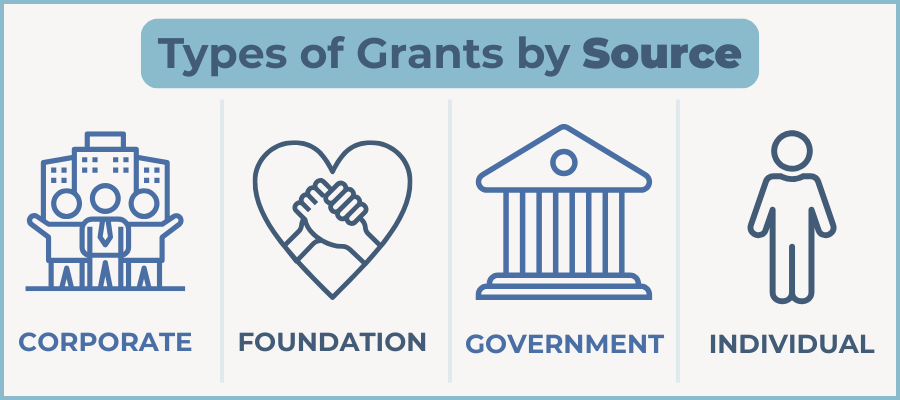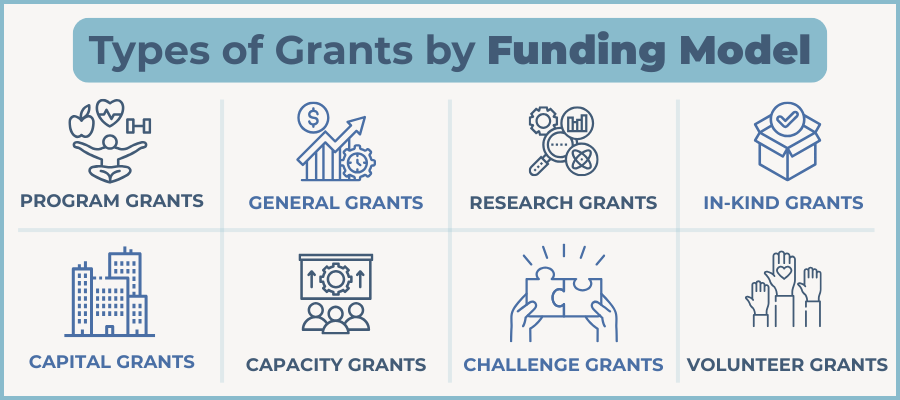A Deep Dive Into Types of Grants for Nonprofits
Grants are a vital source of funding for nonprofits, helping organizations launch new programs, expand services, and amplify their impact. But navigating the world of grants can feel overwhelming, especially with so many different types of grants for nonprofits available.
From government awards to corporate funding and foundation support, each grant type comes with its own criteria, benefits, and application strategies. In this post, we’ll take a deep dive into the various types of grants that are available to nonprofits.
Let’s break them down so you can better understand where to look for funding and how to approach each opportunity. Specifically, we’ll cover:
- What Are Grants for Nonprofits?
- Types of Grants for Nonprofits by Source
- Types of Grants for Nonprofits by Funding Model
- How to Identify the Best Types of Grants for Your Cause
Whether you’re a seasoned grant writer or are just starting out, this guide will help you chart a clearer course through today’s vast grant landscape.
Let’s begin with the basics.
What Are Grants for Nonprofits?
Grants for nonprofits are financial awards given by government agencies, foundations, corporations, or other organizations to support a nonprofit’s mission-driven work. Unlike loans, grants do not need to be repaid, making them an attractive source of funding for nonprofits looking to launch projects, expand services, or cover operational costs.
At their core, grants are a way for funders to invest in causes they care about—whether that’s education, healthcare, the environment, social justice, or countless other issues. Nonprofits apply for these funds by submitting proposals that outline their goals, strategies, budgets, and expected impact of their work. If selected, they receive funding to carry out the proposed activities, often with certain reporting or accountability requirements attached.
All in all, grants can vary widely in size, scope, and structure. Some are one-time awards for specific projects, while others provide multi-year support or unrestricted funds that can be used flexibly across an organization’s needs.
While competitive in nature, grants can serve as a transformative kind of funding, helping organizations increase their capacity, drive innovation, and serve more constituents overall.
Types of Grants for Nonprofits by Source
Grants for nonprofits can come from a variety of sources, each with its own priorities, application processes, and funding structures. Understanding where grant money originates can help you target the right opportunities and tailor your proposals more effectively.
Below are the main sources of grants for nonprofits that your team should be familiar with.

Corporate
Corporate grants are financial contributions made by businesses or companies to nonprofit organizations, typically as part of their corporate social responsibility (or CSR) initiatives. These grants may be distributed directly by the company or through a corporate foundation, and they are often aligned with the company’s values, marketing goals, or community engagement strategies.
Corporate grants can take many forms, such as sponsorships, matching gift programs, in-kind donations, and cash awards. Some companies also offer employee volunteerism programs that provide funding to nonprofits where their employees volunteer, thereby deepening the relationship between the business and the community.
Foundation
Foundation grants are funds awarded by private, family, or community foundations that exist specifically to support charitable, educational, or cultural causes. A foundation is a type of nonprofit organization itself, created through an initial endowment (often from an individual, family, or corporation), and governed by a board of trustees.
Foundations typically have a formal grantmaking process, and their funds are distributed according to specific program areas or focus areas set forth in their mission and bylaws. These grants are often awarded on a competitive basis, requiring a detailed proposal, budget, and plan for measuring impact. Foundation grants can vary in size and scope, from small project-based funding to multi-year general operating support.
Government
Government grants are funds distributed by public agencies at the federal, state, or local level to support public services, community development, education, health initiatives, and other nonprofit work that aligns with public policy goals. These grants are funded through taxpayer dollars and are administered by government departments and agencies through formal grant programs.
Federal grants are typically large-scale and have rigorous application and reporting requirements. State and local governments also offer grants, often targeted at more region-specific needs like housing, transportation, or youth programs. Applying for government grants generally involves a structured process, including detailed proposals and compliance with strict regulations. While they can be difficult to secure due to competition and bureaucracy, government grants provide substantial and reliable funding that can support long-term programs, infrastructure development, and community-wide impact.
Individual
Individual grants refer to financial contributions given directly by private individuals to nonprofit organizations, often in the form of major gifts or personal philanthropic donations. While not always termed “grants” in the traditional sense, large individual gifts function similarly by providing targeted funding that supports specific programs, capital campaigns, or general operations. These contributions may come from high-net-worth individuals, philanthropists, or family-run charitable vehicles that operate outside of formal foundations. In many cases, individual donors are motivated by a personal connection to a cause or a desire to make a tangible difference in a particular area of interest.
Cultivating individual donor relationships is crucial for securing this type of funding. Unlike institutional grants, individual gifts often involve more personal engagement, such as one-on-one meetings, customized proposals, and regular updates on the impact of the donation. While these grants may be less formal than foundation or government grants, they are an essential component of nonprofit sustainability and often lead to long-term partnerships, legacy gifts, and involvement in fundraising campaigns or boards of directors.
Types of Grants for Nonprofits by Funding Model
Grants don’t just differ by who provides the funding—they also vary in how the funds are structured and distributed. Understanding the different funding models can help your nonprofit apply more strategically and manage awarded grants more effectively.
Below are the most common types of grants for nonprofits, categorized by funding model:

Program grants
Program grants are the most common type of funding provided to nonprofits and are designated to support specific projects or initiatives. These grants are generally considered to be restricted, meaning the funds must be used exclusively for the program described in the grant application. Whether it’s a youth mentorship initiative, an after-school arts program, or a mental health outreach service, program grants allow organizations to launch or expand targeted efforts that align with a funder’s priorities.
Funders awarding program grants typically want to see a detailed proposal that includes objectives, timelines, budgets, and measurable outcomes. These grants require nonprofits to track how every dollar is spent and report on progress regularly. While they offer valuable funding for mission-aligned work, the restrictions mean nonprofits must manage them carefully and ensure they’re not used for unrelated expenses like rent or administrative salaries.
General operating support grants
General operating support grants—often referred to as “unrestricted” funding—are highly coveted by nonprofits because they offer maximum flexibility. These grants can be used to cover everyday operational expenses such as staff salaries, office rent, utilities, and program costs. They recognize that strong infrastructure is essential for nonprofit success and allow organizations to allocate funds where they’re needed most.
Unlike program grants, general operating support doesn’t require nonprofits to restrict spending to a specific initiative. This kind of grant is typically awarded to nonprofits with a proven track record and clear impact, as funders need to trust the organization’s leadership and mission. General operating support is critical for sustainability, allowing nonprofits to weather challenges, invest in long-term growth, and adapt to emerging community needs.
Research grants
Research grants fund the systematic investigation of a specific issue, trend, or problem in order to develop new knowledge, test hypotheses, or evaluate outcomes. These are especially common in healthcare, education, and social sciences, where data and evidence can lead to better services and policy changes. Nonprofits seeking research grants usually need to demonstrate expertise in data collection, analysis, and dissemination.
Funders of research grants—such as government agencies, foundations, or academic institutions—expect detailed research designs, ethical oversight, and publishable results. These grants can be large and long-term, covering expenses like staff time, participant compensation, equipment, and data analysis tools. While they don’t always fund direct services, research grants help nonprofits contribute valuable insights and shape the future of their field.
In-kind grants
In-kind grants provide non-cash resources that support a nonprofit’s operations or programs. These can include donated goods (like food, clothing, equipment, or furniture) and services (such as legal help, marketing, IT support, or venue space). In-kind contributions reduce the need for cash expenditures, making them especially valuable for nonprofits with limited budgets.
Corporations, foundations, and individuals may offer in-kind grants as part of broader philanthropic strategies. For example, a tech company might donate laptops to an education-based nonprofit, or a law firm could offer pro bono legal services to help with incorporation or compliance. While in-kind grants don’t appear on the balance sheet the same way cash does, they provide tangible value and can significantly enhance program delivery and efficiency.
Capital grants
Capital grants are designated for building, renovating, or purchasing physical assets like facilities, land, or major equipment. These grants help nonprofits undertake large-scale projects such as constructing a new community center, updating technology infrastructure, or acquiring vehicles for transportation services. They are often one-time investments intended to improve an organization’s capacity and sustainability.
Because capital projects are complex and expensive, grant proposals generally must include architectural plans, budgets, timelines, and long-term maintenance plans. After all, funders want assurance that the investment will have a lasting impact and that the nonprofit can manage the facility effectively. Many capital campaigns combine grants with individual fundraising, making these projects a true test of strategic planning and community support.
Capacity-building grants
Capacity-building grants are designed to strengthen a nonprofit’s internal operations and long-term effectiveness. Rather than funding direct services, these grants invest in the organization itself, supporting activities such as leadership training, strategic planning, evaluation systems, or board development. The goal is to increase the nonprofit’s ability to fulfill its mission more efficiently and sustainably.
Funders providing capacity-building grants understand that strong infrastructure is as essential as strong programs. These grants help nonprofits adapt to growth, improve their systems, and build resilience. While they may not produce immediate client outcomes, capacity-building investments often result in improved impact, scalability, and funder readiness in the long run.
Challenge or matching grants
Challenge grants, or matching grants, require nonprofits to raise a certain amount of money in order to receive funds. For example, a foundation might offer a $50,000 grant. However, it will only be awarded if the nonprofit raises an equivalent amount from individual donors and other sources. This model is used to incentivize fundraising, expand donor bases, and demonstrate public support for a cause.
These grants can be powerful tools for leveraging additional funding and creating urgency among supporters. They also show that the nonprofit is capable of mobilizing its community and has diverse financial support.
Volunteer grants
Volunteer grants are offered by corporations to support the nonprofits where their employees volunteer. When an employee donates a certain number of hours to a nonprofit, the employer will make a monetary donation to the organization on their behalf. This is part of many companies’ broader employee engagement and corporate social responsibility programs.
Volunteer grants incentivize employees to engage with causes they care about. Plus, they help nonprofits benefit from both time and financial resources. For example, if an employee volunteers 20 hours, their employer might donate $250 to the nonprofit. Nonprofits can maximize these opportunities by tracking volunteer hours, promoting eligible programs, and building relationships with corporate partners.
How to Identify the Best Types of Grants for Your Cause
With so many grant opportunities available, one of the biggest challenges is figuring out which ones are the right fit. After all, not every grant will align with your mission, size, or capacity. And applying for the wrong ones isn’t always the best use of your valuable time and resources.
That said, here’s how you can identify the best types of grants for your cause:
1. Clarify Your Mission and Funding Needs
Start by getting clear on what you need funding for. Are you launching a new program? Covering operational costs? Expanding into a new community? Your specific goals will help narrow down the types of grants that make sense—whether project-specific, unrestricted, or capacity-building grants.
2. Match Grant Types to Your Organization’s Size and Structure
Some grants are geared toward large, established nonprofits, while others are designed for grassroots or community-based organizations. Look for grants that are realistic for your current stage of growth. For example, a small nonprofit may have better luck with local foundation grants or in-kind donations than with a large federal grant that requires extensive reporting.
3. Research Funders Aligned with Your Cause
Seek funders with a history of supporting organizations in your issue area—whether education, healthcare, environmental justice, or the arts. Review their past grantees and funding priorities. If your mission aligns with their values, your chances of success are much higher.
4. Consider Geographic Focus
Many funders have a geographic preference or restriction. Look for grants that specifically serve your region, city, or state. Regional and community foundations and local corporate giving programs are often more accessible and invested in community-level impact.
5. Evaluate Grant Requirements and Capacity Fit
Some grants come with extensive application processes, reporting requirements, or performance metrics. Make sure you have the staff, systems, and time to manage the expectations before applying. A smaller, simpler grant that you can handle effectively might be a better fit than a large, complex one that you lack the bandwidth to manage.
6. Use Grant Databases and Networks
Tools like Candid’s Foundation Directory Online, GrantStation, and state nonprofit associations can help you search and filter grants based on your focus area, location, and funding needs. Not to mention, Double the Donation’s corporate giving database can be an excellent source of information on corporate grant opportunities. Meanwhile, networking with other nonprofits can also lead to insider knowledge about grants that may not be widely advertised.
By carefully aligning your mission, goals, and capacity with the right types of grants, you increase your chances of not only winning funding but also making the most of it.
Wrapping Up & Additional Grant-Seeking Resources
Grants come in many forms. Understanding the differences can make all the difference in securing the right funding for your mission. From restricted and unrestricted funds to government contracts and corporate giving programs, each type opens doors to unique opportunities.
By aligning your nonprofit’s goals with the right kind of grant, you not only increase your chances of funding success. You also position your organization for long-term sustainability and growth.
As you explore the options covered in this guide, remember this: the best grant isn’t necessarily the biggest check. It’s the one that best fits your mission, values, and capacity to deliver results.
Good luck, and happy grant-seeking!
For more information on nonprofit grants and beyond, check out these additional recommended resources:
- Corporate Grants for Nonprofits: Tips for Raising More. Learn how to tap into corporate funding! Explore practical tips on identifying potential partners, crafting compelling proposals, and building relationships with companies that give back.
- Companies That Give Grants: 20 Leading Businesses. Explore a curated list of 20 major companies that actively support nonprofits through grant programs. It’s a great place to start your search!
- 35 In-Kind Giving & Grant Statistics Nonprofits Should Know. Back your fundraising strategy with powerful data. This post highlights key statistics on in-kind donations, grant trends, and corporate philanthropy to help you stay informed and focused.




